A sari or saree is a strip of unstitched cloth, worn by females, ranging from four to nine yards in length that is draped over the body in various styles. It is popular in India, Bangladesh, Nepal, Pakistan, Sri Lanka, Bhutan, Burma, Malaysia, and Singapore. The most common style is for the sari to be wrapped around the waist, with one end then draped over the shoulder, baring the midriff.
The sari is usually worn over a petticoat (लहंगा lahaṅgā or lehenga) in the north, langa, pavada, or pavadai in the south, chaniyo, parkar, ghaghra, or ghagaro in the west, and shaya in eastern India), with a blouse known as a choli or ravika forming the upper garment. The blouse has short sleeves and a low neck and is usually cropped at the midriff, and as such is particularly well-suited for wear in the sultry South Asian summers. Cholis may be backless or of a halter neck style. These are usually more dressy, with plenty of embellishments such as mirrors or embroidery, and may be worn on special occasions. Women in the armed forces, when wearing a sari uniform, don a short-sleeved shirt tucked in at the waist. The sari developed as a garment of its own in both South and North India at around the same time, and is in popular culture an epitome of Indian culture. The sari signified the grace of Indian women adequately displaying the curves at the right places.
Origins and history
The word sari is derived from Sanskrit शाटी śāṭī which means 'strip of cloth' and शाडी śāḍī or साडी sāḍī in Prakrit, and which was corrupted to sāṛī in Hindi.In the history of Indian clothing the sari is traced back to the Indus Valley Civilisation, which flourished during 2800–1800 BC around the western part of the Indian subcontinent. The earliest known depiction of the sari in the Indian subcontinent is the statue of an Indus Valley priest wearing a drape.
Ancient Tamil poetry, such as the Silappadhikaram and the Sanskrit work, Kadambari by Banabhatta, describes women in exquisite drapery or sari. In ancient Indian tradition and the Natya Shastra (an ancient Indian treatise describing ancient dance and costumes), the navel of the Supreme Being is considered to be the source of life and creativity, hence the midriff is to be left bare by the sari.
Sculptures from the Gandhara, Mathura and Gupta schools (1st–6th century AD) show goddesses and dancers wearing what appears to be a dhoti wrap, in the "fishtail" version which covers the legs loosely and then flows into a long, decorative drape in front of the legs. No bodices are shown.
Other sources say that everyday costume consisted of a dhoti or lungi (sarong), combined with a breast band and a veil or wrap that could be used to cover the upper body or head. The two-piece Kerala mundum neryathum (mundu, a dhoti or sarong, neryath, a shawl, in Malayalam) is a survival of ancient Indian clothing styles. The one-piece sari is a modern innovation, created by combining the two pieces of the mundum neryathum.
It is generally accepted that wrapped sari-like garments, shawls, and veils have been worn by Indian women for a long time, and that they have been worn in their current form for hundreds of years.
The tightly fitted, short blouse worn under a sari is a choli. Choli evolved as a form of clothing in the 10th century AD, and the first cholis were only front covering; the back was always bare but covered with end of saris pallu or veil. Bodices of this type are still common in the state of Rajasthan.
In Kerala and Tamil Nadu, it is indeed documented that women from many communities wore only the sari and exposed the upper part of the body till the 20th century. Poetic references from works like Silappadikaram indicate that during the Sangam period in ancient Tamil Nadu, a single piece of clothing served as both lower garment and head covering, leaving the breasts and midriff completely uncovered. In Kerala there are many references to women being bare-breasted, including many paintings by Raja Ravi Varma.
In ancient India, although women wore saris that bared the midriff, the Dharmasastra writers stated that women should be dressed such that the navel would never become visible. By which for some time the navel exposure became a taboo and the navel was concealed.
Styles of draping
There are more than 80 recorded ways to wear a sari. Fashion designer Shaina NC declared,"I can drape a sari in 54 different styles".The most common style is for the sari to be wrapped around the waist, with the loose end of the drape to be worn over the shoulder, baring the midriff. However, the sari can be draped in several different styles, though some styles do require a sari of a particular length or form. The French cultural anthropologist and sari researcher Chantal Boulanger categorized sari drapes in the following families:
- Nivi – styles originally worn in Andhra Pradesh; besides the modern nivi, there is also the kaccha nivi, where the pleats are passed through the legs and tucked into the waist at the back. This allows free movement while covering the legs.
- Bengali and Oriya style.
- Gujarati – after tucking in the pleats similar to the Nivi style, the loose end is taken from the back, draped across the right shoulder, and pulled across to be secured in the back
- Maharashtrian/Konkani/Kashta; this drape is very similar to that of the male Maharashtrian dhoti. The center of the sari (held lengthwise) is placed at the center back, the ends are brought forward and tied securely, then the two ends are wrapped around the legs. When worn as a sari, an extra-long cloth of nine yards is used and the ends are then passed up over the shoulders and the upper body. They are primarily worn by Brahmin women of Maharashtra, Karnataka, Andhra Pradesh and Goa.
- Dravidian – sari drapes worn in Tamil Nadu; many feature a pinkosu, or pleated rosette, at the waist.
- Madisar – this drape is typical of Iyengar/Iyer Brahmin ladies from Tamil Nadu.
- Kodagu style – this drape is confined to ladies hailing from the Kodagu district of Karnataka. In this style, the pleats are created in the rear, instead of the front. The loose end of the sari is draped back-to-front over the right shoulder, and is pinned to the rest of the sari.
- Gobbe Seere – This style is worn by women in the Malnad or Sahyadri and central region of Karnataka. It is worn with 18 molas saree with three four rounds at the waist and a knot after crisscrossing over shoulders.
- Gond – sari styles found in many parts of Central India. The cloth is first draped over the left shoulder, then arranged to cover the body.
- Malayali style – the two-piece sari, or Mundum Neryathum, worn in Kerala. Usually made of unbleached cotton and decorated with gold or colored stripes and/or borders. Also the Set-saree, a sort of mundum neryathum.
- Tribal styles – often secured by tying them firmly across the chest, covering the breasts.
- Kunbi style or denthli:Goan Gauda and Kunbis,and those of them who have migrated to other states use this way of draping Sari or Kappad,this form of draping is created by tying a knot in the fabric below the shoulder and a strip of cloth which crossed the left shoulder was fasten on the back.
Nivi style
The nivi is today's most popular sari style.The nivi drape starts with one end of the sari tucked into the waistband of the petticoat, usually a plain skirt. The cloth is wrapped around the lower body once, then hand-gathered into even pleats below the navel. The pleats are tucked into the waistband of the petticoat. They create a graceful, decorative effect which poets have likened to the petals of a flower.
After one more turn around the waist, the loose end is draped over the shoulder. The loose end is called the pallu, pallav, seragu, or paita depending on the language. It is draped diagonally in front of the torso. It is worn across the right hip to over the left shoulder, partly baring the midriff. The navel can be revealed or concealed by the wearer by adjusting the pallu, depending on the social setting. The long end of the pallu hanging from the back of the shoulder is often intricately decorated. The pallu may be hanging freely, tucked in at the waist, used to cover the head, or used to cover the neck, by draping it across the right shoulder as well. Some nivi styles are worn with the pallu draped from the back towards the front, coming from the back over the right shoulder with one corner tucked by the left hip, covering the torso/waist. The nivi sari was popularised through the paintings of Raja Ravi Varma. In one of his paintings, the Indian subcontinent was shown as a mother wearing a flowing nivi sari. Also, partly due to Bollywood actresses wearing it this way in 1920s and 1930s.
The ornaments generally accepted by the Hindu culture that can be worn in the midriff region are the waist chains. They are considered to be a part of bridal jewellery.
Modern style of draping
The increased interaction with the British saw most women from royal families come out of purdah in the 1900s. This necessitated a change of dress. Maharani Indira Devi of Cooch Behar popularised the chiffon sari. She was widowed early in life and followed the convention of abandoning her richly woven Baroda shalus in favour of the traditional unadorned white. Characteristically, she transformed her ‘mourning’ clothes into high fashion. She had saris woven in France to her personal specifications, in white chiffon, and introduced the silk chiffon sari to the royal fashion repertoire. The chiffon sari did what years of fashion interaction had not done in India. It homogenised fashion across this land. Its softness, lightness and beautiful, elegant, caressing drape was ideally suited to the Indian climate.Different courts adopted their own styles of draping and indigenizing the sari. In most of the courts the sari was embellished with stitching hand-woven borders in goldfrom Varanasi, delicate zardozi work, gota, makaish and tilla work that embellished the plain fabric, sumiltaneously satisfying both traditional demands and ingrained love for ornamentation. Some images of maharanis in the Deccan show the women wearing a sleeveless, richly embellished waistcoat over their blouses. The Begum of Savanur remembers how sumptuous the chiffon sari became at their gatherings. At some courts it was worn with jaali, or net kurtas and embossed silk waist length sadris or jackets. Some of them were so rich that the entire ground was embroidered over with pearls and zardozi.
Due to migration to Western countries like South Africa, many Indian women began to wear the normal sari below the waistline exposing the navel, known as low-rise sari or low hip sari. Thus, the space between the bottom of the sari blouse and the top of the petticoat began to expand to expose the navel or a healthy roll of fat instead of only a couple of inches of skin. Also due to liberalization and changing global fashion trends, saris are reemerging as a dress which can expose as much as it conceals. As a result, saris began to be designed in many innovative ways and materials. Transparent and semi-transparent saris made of sheer fabrics like chiffon are an example.Heavily embroidered saris gave way to printed nylons and polyesters.
These saris are draped in different ways such as petticoat being tied at about 4–6 inches below the navel or where the blouse is small and ends just below the breasts and the pallu is thin, thereby exposing the some part of the blouse and almost the entire midriff. Fashion designer Suneet Varma once commentd,"The saree is the most versatile garment in the world. It can, with a sweep of the head, be conservative or with a flash of the navel, trendy. If you are going for a prayer meeting, all you need to do is to place the pallu over the shoulders or cover your head with it. The same saree, worn a little low to show off the navel, and teamed up with a backless choli, and show a bit of cleavage, can make you the most elegant woman at a cocktail party." Designer Shaina NC once commented,“There’s no reason why saris must be worn over a petticoat — I’m wearing mine over trousers.There’s no set rules — take your pleats to the side or over the hip, wear the pallav like a dupatta or try a double or triple sari." Some even wear navel jewels or navel piercings to draw attention to the navel.
This were made popular by the celebrities of Bollywood industry and other popular regional film industries like Kannada, Tamil and Telugu cinemas. For example,in the 1968 Bollywood film Brahmachari, Actress Mumtaz was seen in a Sharara sari flaunting her navel for a song and dance number ("Aaj kal tere mere"). Sharara is a long flowing pant like a divided skirt at bottom with a long blouse. The unique feature of the Sharara is the skirt which has less flow than lehenga. It is like a loose pant fitted till the knee, with a big flare from the knee onwards. Different types of fabrics are used for sharara like rich tissue materials such as Crape, Satin, Chiffon, Georgette and Silk. It later became so popular that till date this type of saris is known to be Mumtaz Saris. Recently in 2009, actress Priyanka Chopra appeared in a similar type "Mumtaz Sari" and showed off her navel jewellery when she attended the premiere of her film What's Your Raashee at the Toronto International Film Festival.
Above mentioned modern saris are mainly worn by rich and educated upper-class women. Wearing the sari below the navel doesn't always lead to exposing it, as the navel is covered with the pallu in a low-rise non-transparent sari. This style can be helpful for tall women for whom tying the sari above the navel might not be possible. The pallu helps in covering the navel.In Indian corporate culture, saris are required to be worn in an elegant manner avoiding navel exposure. Anita Gupta, Senior Vice-President at JWT Chennai commented,"Formal wear for women definitely covers saris without plunging necklines or glimpses of the belly button."
Professional Style of Draping
Because of the harsh extremes in temperature on the Indian Subcontinent, the sari fills a practical role as well as a decorative one. It is not only warming in winter and cooling in summer, but its loose-fitting tailoring is preferred by women who must be free to move as their duties require. For this reason, it is the costume of choice of air hostesses on Air India. This led to a professional style of draping a sari which is referred to Air-Hostess style sari. An air hostess style sari is tied in just the same way as a normal sari except that the pleats are held together quite nicely with the help of pins. A bordered sari will be just perfect for an Air-Hostess style drape where the pallu is heavily pleated and pinned on the shoulder. Even the vertical pleats that are tucked at the navel are severely pleated and pressed. Same goes for the pallu pleats that are pinned at the shoulder. To get the perfect ‘Air-hostess’ a complimentary U-shaped blouse that covers the upper body completely is worn which gives a very elegant and formal look. Mastering the ‘Air-hostess’ style drape helps to create the desired impact in a formal setting like an interview or a conference.Saris are worn as uniforms by the female hotel staff of many five star luxury hotels in India as symbol of culture. Recently in a makeover design, Taj Hotels Resorts and Palaces, decided the welcoming staff at the group's Luxury Hotels would be draped in the rich colours and designs of the Banarasi six yards. The new saris were unveiled at the Taj property in Mumbai. It will be subsequently replicated at all 10 Luxury Hotels of the group across the country for duty managers and front office staff. Taj had adopted three villages in Varanasi and employed 25 master weavers there for the project. The vision finally took shape after 14 months, once the weavers had a good work environment, understood the designs and fine-tuned the motifs.
Similarly, the female politicians of India wear the sari in a professional manner. The women of Nehru–Gandhi family like Indira Gandhi and Sonia Gandhi wear the special blouse for the campaign trail which is longer than usually and is tucked in to prevent any midriff show while waving to the crowds.Stylist Prasad Bidapa has to say, “I think Sonia Gandhi is the country's most stylish politician. But that's because she's inherited the best collection of saris from her mother-in-law. I'm also happy that she supports the Indian handloom industry with her selection.” BJP politician Sushma Swaraj maintains her prim housewife look with a pinned-up pallu while general secretary of AIADMK Jayalalithaa wears her saris like a suit of armour.
Bangladesh
The shari is worn by women throughout Bangladesh. Sari is the most popular dress for women in Bangladesh, both for casual and formal occasion. There are many regional variations of them in both silk and cotton. But the Jamdani Tanta/Tant cotton, Dhakai Benaroshi, Rajshahi silk, Tangail Tanter shari, Tash-Har silk, and Katan shari are the most popular in Bangladesh.Pakistan
In Pakistan, saris are less commonly worn than the Shalwar kameez which is worn throughout the country. Because of its long association with the Hindu culture and it exposing the midriff and navel, sari are considered to be against the injunctions of Islam and as a 'Hindu dress'. Even though the sari has been worn by people living in the region that is now Pakistan since ancient times, it has lost popularity since 1947. Many Islamic right-wing elements have pressed on a move to ban saris. However, the sari remains a popular garment among the upper class for many formal functions. The sari is worn as daily wear by Pakistani Hindus, by elderly Muslim women who were used to wearing it in pre-partition India and by some of the new generation who have reintroduced the interest in saris. The growing popularity of the sari among Pakistan's fashion-conscious elite is due to another bete noire of conservatives - Bollywood movies and television serials. The Nation, an English-language newspaper published from Lahore reported, "The Indian electronic media have played an important role in promoting the sari culture in Pakistan. Now Pakistani actresses on TV channels are being seen wearing saris, especially young women."Sri Lanka
Sri Lankan women wear saris in many styles. Two ways of draping the sari are popular and tend to dominate: the Indian style (classic nivi drape) and the Kandyan style (or osaria in Sinhalese). The Kandyan style is generally more popular in the hill country region of Kandy from which the style gets its name. Though local preferences play a role, most women decide on style depending on personal preference or what is perceived to be most flattering for their figure.The traditional Kandyan (osaria) style consists of a full blouse which covers the midriff completely and is partially tucked in at the front as is seen in this 19th-century portrait. However, modern intermingling of styles has led to most wearers baring the midriff. The final tail of the sari is neatly pleated rather than free-flowing. This is rather similar to the pleated rosette used in the Dravidian style noted earlier in the article.
The Kandyan style is considered the national dress of Sinhalese women. It is the uniform of the air hostesses of SriLankan Airlines.
During 1960s, the mini sari known as 'hipster' sari created a wrinkle in Sri Lankan fashion, since it was worn below the navel and barely above the line of prosecution for indecent exposure. The conservative people described the 'hipster' as "an absolute travesty of a beautiful costume almost a desecration" and "a hideous and purposeless garment".
Nepal
Saree is the most commonly worn women uniform in Nepal. Since the time immemorial saree is worn by Nepalese women. It is more importantly worn in religious activities. A woman wearing a saree is regarded as sober lady. A lady with sari seems elegant, gorgeous and sensuous. However, nowadays, modern women prefer a uniform other than a saree for their convenience.In Nepal, a special style of draping is used in a sari called haku patasihh. The sari is draped around the waist and a shawl is worn covering the upper half of the sari, which is used in place of a pallu.
Cloth
Saris are woven with one plain end (the end that is concealed inside the wrap), two long decorative borders running the length of the sari, and a one to three foot section at the other end which continues and elaborates the length-wise decoration. This end is called the pallu; it is the part thrown over the shoulder in the Nivi style of draping.In past times, saris were woven of silk or cotton. The rich could afford finely-woven, diaphanous silk saris that, according to folklore, could be passed through a finger ring. The poor wore coarsely woven cotton saris. All saris were handwoven and represented a considerable investment of time or money.
Simple hand-woven villagers' saris are often decorated with checks or stripes woven into the cloth. Inexpensive saris were also decorated with block printing using carved wooden blocks and vegetable dyes, or tie-dyeing, known in India as bhandani work.
More expensive saris had elaborate geometric, floral, or figurative ornaments or brocades created on the loom, as part of the fabric. Sometimes warp and weft threads were tie-dyed and then woven, creating ikat patterns. Sometimes threads of different colors were woven into the base fabric in patterns; an ornamented border, an elaborate pallu, and often, small repeated accents in the cloth itself. These accents are called buttis or bhuttis (spellings vary). For fancy saris, these patterns could be woven with gold or silver thread, which is called zari work.
Sometimes the saris were further decorated, after weaving, with various sorts of embroidery. Resham work is embroidery done with colored silk thread. Zardozi embroidery uses gold and silver thread, and sometimes pearls and precious stones. Cheap modern versions of zardozi use synthetic metallic thread and imitation stones, such as fake pearls and Swarovski crystals.
In modern times, saris are increasingly woven on mechanical looms and made of artificial fibers, such as polyester, nylon, or rayon, which do not require starching or ironing. They are printed by machine, or woven in simple patterns made with floats across the back of the sari. This can create an elaborate appearance on the front, while looking ugly on the back. The punchra work is imitated with inexpensive machine-made tassel trim.
Hand-woven, hand-decorated saris are naturally much more expensive than the machine imitations. While the overall market for handweaving has plummeted (leading to much distress among Indian handweavers), hand-woven saris are still popular for weddings and other grand social occasions.
The sari goes International
The traditional sari made an impact in the United States during the 1970s. Eugene Novack who ran the New York store, Royal Saree House told that he had been selling it mainly to the Indian women in New York area but later many American business women and housewives became his customers who preferred their saris to resemble the full gown of the western world. He also said that men appeared intrigued by the fragility and the femininity it confers on the wearer. Newcomers to the sari report that it is comfortable to wear, requiring no girdles or stockings and that the flowing garb feels so feminine with unusual grace.As a nod to the fashion-forward philosophy established by the designs of Emilio Pucci, the now-defunct Braniff International Airways envisioned their air hostesses wearing a more revealing version of a sari on a proposed Dallas-Bombay (conceivably via London) service in the late 1970s. However this was never realized due to Halston's resistance to working with a palette outside of his comfort zone. The former Eagan, Minnesota–based Northwest Airlines considered issuing saris to flight attendants working the Minneapolis-Amsterdam-Delhi route that began in the 1990s. This never occurred largely due to a union dispute.
The sari has gained its popularity internationally due to the growth of Indian fashion trends globally. Many Bollywood celebrities, like Aishwarya Rai, have worn it at international events representing the Indian culture. In 2010, Bollywood actress Deepika Padukone wanted to represent her country at an international event, wearing the national costume. On her very first red carpet appearance at the Cannes International Film Festival, she stepped out on the red carpet in a Rohit Bal sari.
Even popular Hollywood celebrities have worn this traditional attire. Pamela Anderson made a surprise guest appearance on Bigg Boss, the Indian version of Big Brother, dressed in a sari that was specially designed for her by Mumbai-based fashion designer Ashley Rebello.Ashley Judd donned a purple sari at the YouthAIDS Benefit Gala in November 2007 at the Ritz Carlton in Mclean, Virginia. There was an Indian flavour to the red carpet at the annual Fashion Rocks concert in New York, with designer Rocky S walking the ramp along with Jessica, Ashley, Nicole, Kimberly and Melody – the Pussycat Dolls – dressed in saris.
Types
While an international image of the modern style sari may have been popularised by airline stewardesses, each region in the Indian subcontinent has developed, over the centuries, its own unique sari style. Following are other well-known varieties, distinct on the basis of fabric, weaving style, or motif, in South Asia:Central styles
- Chanderi – Madhya Pradesh
- Maheshwari – Madhya Pradesh
- Kosa silk – Chattisgarh
Eastern styles
- Sambalpuri Saree silk & Cotton – Sambalpur, Orissa
- Ikkat Silk & Cotton – Bargarh, Orissa
- Tangail cotton – Bangladesh
- Jamdani – Bangladesh
- Muslin – Bangladesh
- Rajshahi Silk – Bangladesh
- Tussar Silk – Bihar
- Mooga silk – Assam
- Tant famous Bengali cotton – Shantipur, West Bengal
- Dhaniakhali cotton – West Bengal
- Murshidabad silk – West Bengal
- Baluchari silk – West Bengal
- Kantha Silk & Cotton Saris - West Bengal
- Khandua Silk & Cotton –Cuttack, Orissa
- Bomkai/Sonepuri Sari Silk & Cotton – Subarnapur, Orissa
- Berhampuri Silk – Bramhapur, Orissa
- Mattha or Tussar Silk –Mayurbhanj, Orissa
- Bapta Silk & Cotton –Koraput, Orissa
- Tanta Cotton –Balasore, Orissa
- Shantipur Cotton – West Bengal
- Phulia Cotton – West Bengal
Western styles
- Paithani – Maharashtra
- Bandhani – Gujarat and Rajasthan
- Kota doria Rajasthan
- Lugade – Maharashtra
- Patola – Gujarat
Southern styles
- Mysore Silk saree Karnataka
- Kanchipuram Sari (locally called Kanjivaram pattu) – Tamil Nadu
- Kumbakonam – Tamil Nadu
- Mundum Neriyathum - Kerala
- Half saree of entire South India
- Thirubuvanam – Tamil Nadu
- Thanjavur – Tamil Nadu
- Madurai – Tamil Nadu
- Coimbatore cotton Tamilnadu
- Arani pattu – Tamil Nadu
- Chinnalapattu Tamilnadu
- Kandangi Seelai Tamilnadu
- Sungudi Seelai Tamilnadu
- Chettinadu Cotton Tamilnadu
- Pochampally – Andhra Pradesh (GI rights applied)
- Venkatagiri – Andhra Pradesh
- Gadwal – Andhra Pradesh
- Guntur – Andhra Pradesh
- Narayanpet – Andhra Pradesh
- Mangalagiri – Andhra Pradesh
- Balarampuram – Kerala
- Mysore silk – Karnataka
- Ilkal – Karnataka
Northern styles
- Banarasi – Uttar Pradesh
- Shalu – Uttar Pradesh
- Tanchoi – Uttar Pradesh
Disadvantages
George Polk Award winner columnist Rangaswamy Satakopan wrote the following as the problems of the sari in an article for Associated Press,- There is no more impractical dress in the world than the sari.
- In summer, the folds stick unpleasantly around the legs.
- In winter, it has no protection against cold.
- In the rains, it collects mud and filth at the hem.
- One hand is tied up to the sari, leaving only hand free to use.
- It has no buttons. When the hem is stepped upon while walking, it might fully slip down.
- It is not suitable to wear during sports.

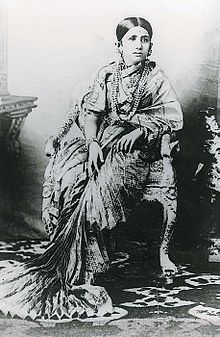

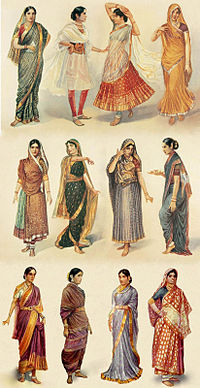






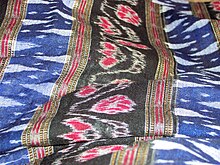

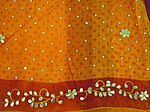









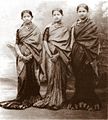










No comments:
Post a Comment